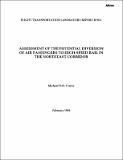| dc.contributor.author | Clarke, Michael D. D. | en_US |
| dc.contributor.other | Massachusetts Institute of Technology. Flight Transportation Laboratory | en_US |
| dc.contributor.other | Massachusetts Institute of Technology. Dept. of Aeronautics and Astronautics | en_US |
| dc.date.accessioned | 2012-01-06T22:29:48Z | |
| dc.date.available | 2012-01-06T22:29:48Z | |
| dc.date.issued | 1994 | en_US |
| dc.identifier | 40704062 | en_US |
| dc.identifier.uri | http://hdl.handle.net/1721.1/68136 | |
| dc.description | Cover title | en_US |
| dc.description | February 1994 | en_US |
| dc.description | Also issued as an M.S. thesis, Dept. of Aeronautics and Astronautics, MIT, 1994 | en_US |
| dc.description | Includes bibliographical references (p. 77-78) | en_US |
| dc.description.abstract | The high level of intercity passenger travel in the Northeast Corridor is supported by densely populated metropolitan city-centers, the suitable distance between the urban areas, and the extent to which economic and social activities in these urban areas complement each other. Within the region, automobile and air travel account for the majority of the passenger traffic. The majority of the air passengers travel on the air shuttles operating in the Northeast. However, since the deregulation of the airline industry, there has been consistent traffic growth on regional carriers. The development of transport modes in the Northeast has been governed by the high level of competition which exists. A passenger's modal choice is influenced by the purpose of the trip. The majority of air shuttle passengers are non-discretionary (business) travellers, who are price insensitive and rely more on air travel because of its convenience and travel time. In 1992, there were 2.41 million air passengers (including regional service) and 600,000 rail passengers travelling in the Boston-New York origin-destination market. The forecasted ridership for high speed rail in this O/D market (2010) is 2.15 to 2.25 million passengers. Of this number, 1.32 million passengers are expected to be diverted from air travel. Based on FAA forecasts for air travel between Boston and New York City in 2010, it is estimated that there will be a twenty-nine percent (29%) diversion of air passengers to high speed rail. | en_US |
| dc.format.extent | 92 p | en_US |
| dc.publisher | [Cambridge, Mass. : Massachusetts Institute of Technology, Dept. of Aeronautics & Astronautics], Flight Transportation Laboratory, [1994] | en_US |
| dc.relation.ispartofseries | FTL report (Massachusetts Institute of Technology. Flight Transportation Laboratory) ; R94-1 | en_US |
| dc.subject | Aeronautics, Commercial | en_US |
| dc.subject | High speed trains | en_US |
| dc.subject | Passenger traffic | en_US |
| dc.subject | Forecasting | en_US |
| dc.subject | Northeastern States | en_US |
| dc.title | Assessment of the potential diversion of air passengers to high-speed rail in the northeast corridor | en_US |
| dc.type | Technical Report | en_US |
